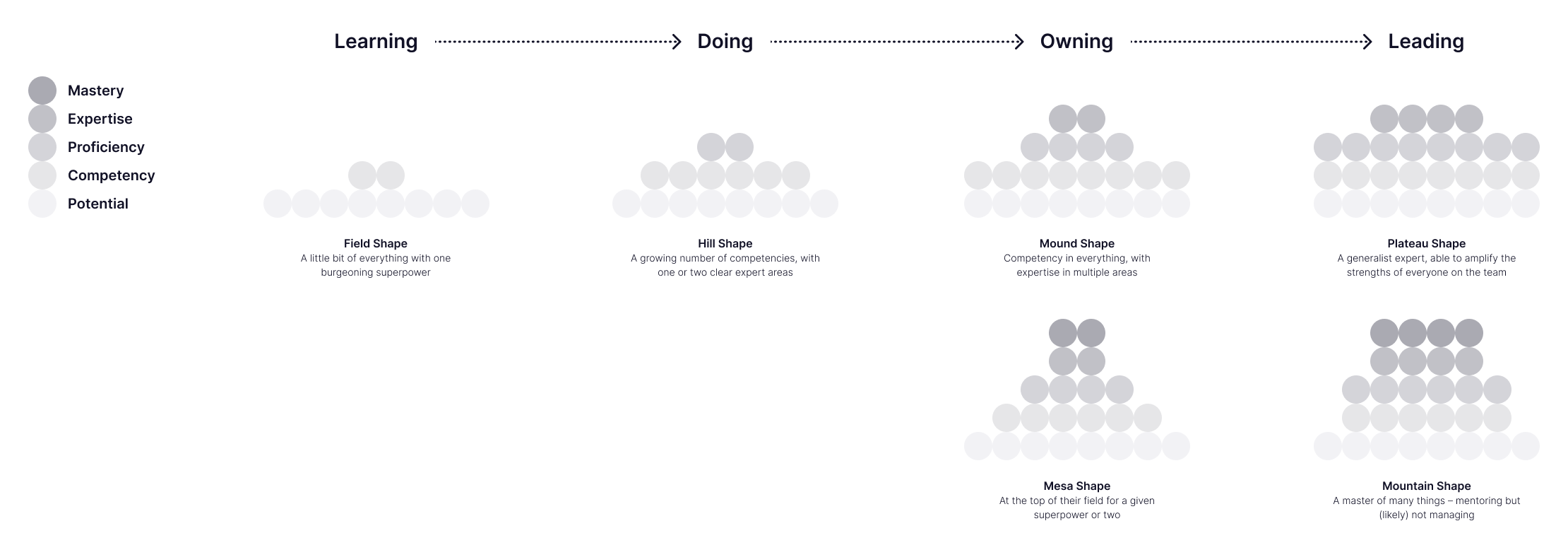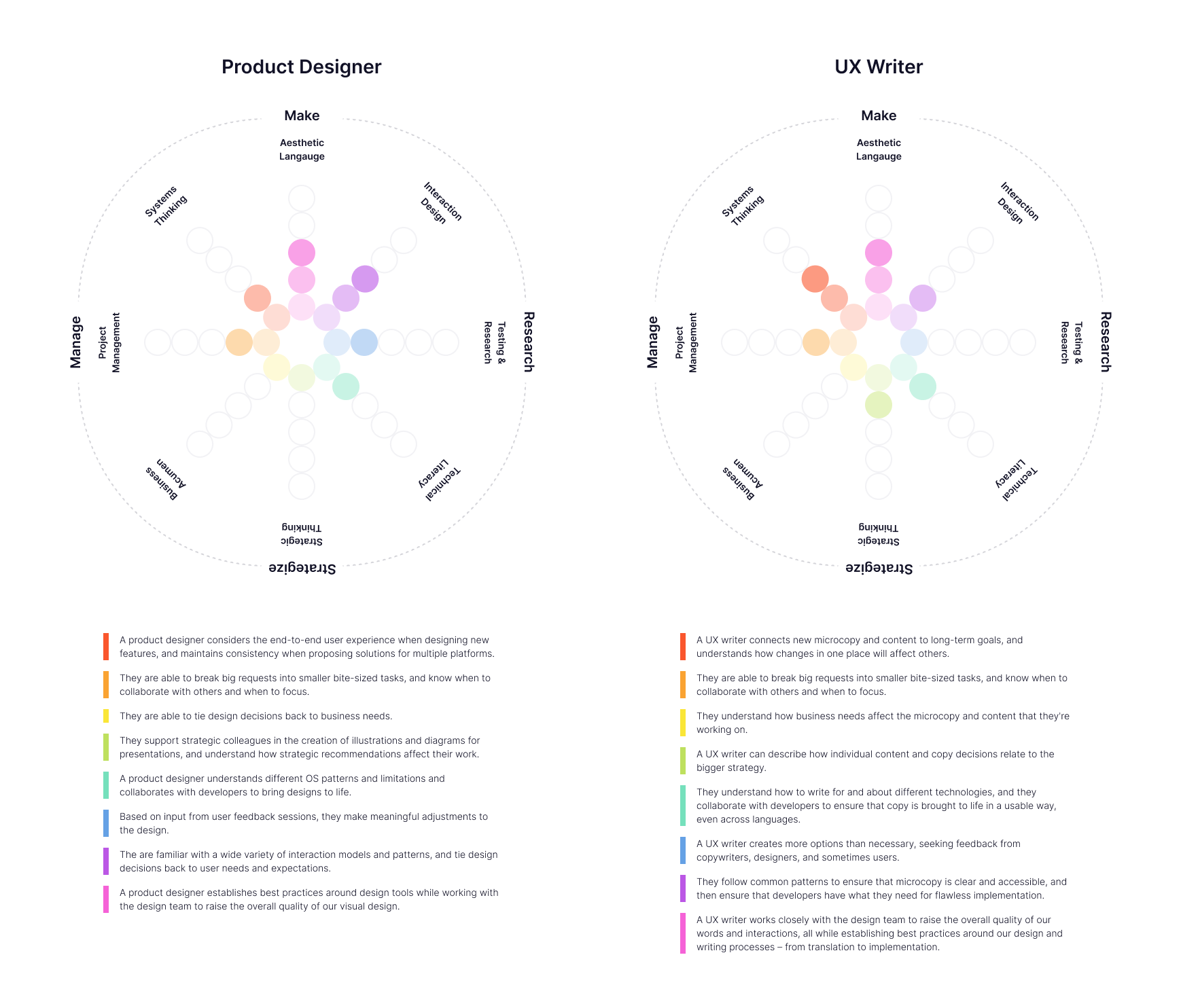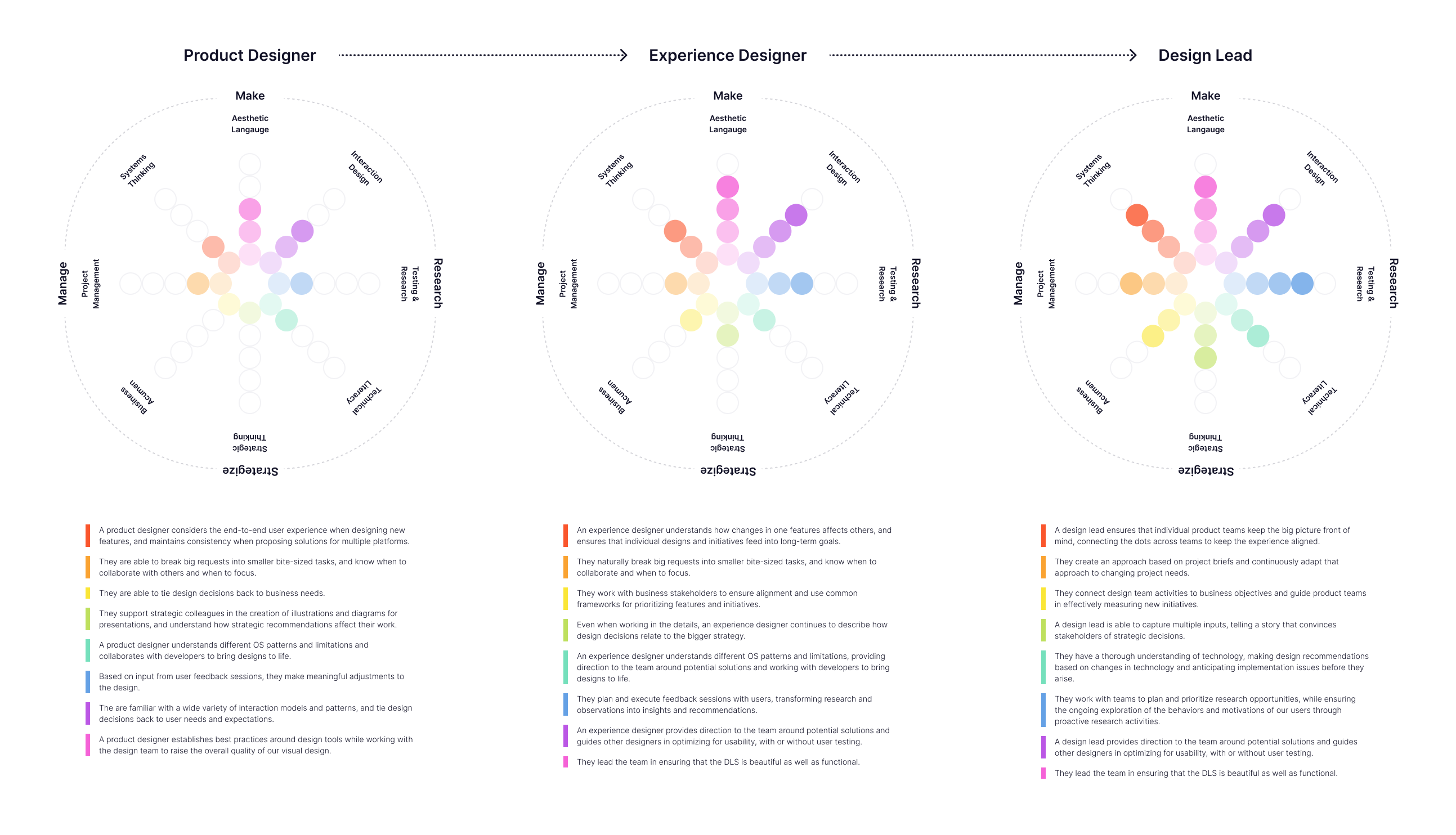2023.08.08
A Growth Framework for Design Teams
It’s been a rough summer. The company I spent the past three years reimagining the future of urban mobility with declared bankruptcy, and what was left of the design team that I built came to an end. There have been countless articles written in a variety of languages discussing the rise and fall of VanMoof, but I’m not going to write about that. What I will share are some of the good stories from the past three years, focusing on what went right. And trust me, there was a lot that went right before it all went wrong.
In this post (hopefully one of many), I’ll share the design team’s growth framework with a look inside the process that created it.
Why is a growth matrix important? Regardless of team, growth matrices provide clarity around individual roles and responsibilities. They help people to understand what’s expected of themselves and of each other, and provide clear guidance for how one can expect to progress in their career. For managers, the growth matrix helps improve retention and engagement, ultimately leading to more creative and empowered teams.
While design often works side-by-side with engineering and development, it’s important for design teams to have their own explicit frameworks for growth to accommodate the unique aspects of their function and ways of working. For example, the relative scale of design teams often leaves less room for specialization, and working across an organization requires a general understanding of business and technology even at entry level design positions.
For context, this was not my first (nor even my second) rodeo. When I was a Senior Designer at Frog Design, I worked on a Frog-specific growth matrix to ensure consistency across studios and continents. Years later, when I opened my own design studio, I created a new version in order to guide designers in their growth by laying out explicit requirements. VanMoof’s was a third, and hopefully better iteration.
Growth matrices are made of a several key components. There are categories that capture the types of skills that you need on your team, and levels highlighting the different stages of maturity for each skill. For each level within each category, there are explicit requirements. Combinations of these requirements are used to define the expectations of your team’s roles and the growth paths of individuals. For a smaller, more homogenous team, level and role might be the same; however, a flexible framework allowing different levels of requirements to be combined can easily scale to accommodate a variety of roles along with more tailored growth paths.
Categories
The Growth Matrix for VanMoof provided a foundation for hiring and growing T-Shaped individuals, promoting overlaps in knowledge and competency, ensuring a more resilient and efficient team. The premise is that everyone would share the same basic knowledge across eight categories: Systems Thinking, Project Management, Business Acumen, Strategic Thinking, Technical Literacy, Testing and Research, Interaction Design, and Aesthetic Language. These categories condensed into four high-level focus areas that accommodated the distinct disciplines of our team: Design, Content, Design Ops, and UX Research.

Systems Thinking
Systems Thinking is the ability to work within a broader system, bringing consistency to both an individual’s work and to the work of the team as a whole. At lower levels, a contributor needs to be able to work within the system; while at higher levels, a senior or lead should define the design systems and best practices that guide the work of others.
Project Management
Project Management, the practice of planning and executing work, is fundamental to the smooth operation of teams. At the entry level, everybody on the team is expected to be able to accurately estimate and deliver on individual tasks. At a senior level, a contributor should be able to break larger, more ambiguous requests into smaller tasks while actively seeking to optimize the process for doing so.
Business Acumen
Whether working in-house or with clients, it’s important for the design team to have empathy for the business. Across roles, individuals need to understand how the needs of the business affect the user experience. With more seniority, it becomes important to tie the team’s activities to the strategy of the business, while leaders should work with the business to set a strategy, complete with measurable outcomes.
Strategic Thinking
Similar to Business Acumen, Strategic Thinking is focused on how the design team engages with the rest of the company; however, the focus here is more holistic: how do we meet the expectations of our users, fulfill the needs of the business, and accommodate the constraints (or possibilities) of our technology? Junior contributors often learn by building the presentations and visualizations that support a strategy’s communication, while senior team members are defining the strategy alongside other leaders in the company.
Technical Literacy
Technical Literacy ensures that the design team is able to work alongside developers and engineers to bring their ideas to life. At the entry level, an individual likely needs to know enough to ask the right questions and deliver quality work that’s platform appropriate. With experience, it’s expected that someone from the design team will be able to effectively challenge technical compromises or to find new opportunities based on emerging capabilities.
Testing & Research
Seeking out and integrating feedback is critical to a design’s success, and the expectation is that everyone on the team will have some understanding of how to do this at an informal level. With experience, the requirements of Testing and Research call for more formality in process and more strategy in approach.
Interaction Design
Finally, the traditional design topics! Interaction Design is focused on understanding and following design patterns. A junior contributor should be able to find and appropriate from successful examples, while a leader should have a deep understanding of design patterns that they draw on to rationalize work and create confidence moving forward (especially in situations where user testing is not possible).
Aesthetic Language
Lastly, Aesthetic Language is what most people think of when they look at a design team. Does it look/sound/feel good? At the start, this means delivering work without serious errors or problems. At more senior levels, it’s expected that someone will deliver work that raises the quality bar and helps define standards across products.
Levels
As each of these descriptions alludes to, there are different expectations or levels within each category, allowing for individuals to learn and mature within the growth matrix. Too few levels won’t allow enough room for growth. Too many levels loses distinction at each jump. The growth matrix at VanMoof used five levels: Potential, Competency, Proficiency, Expertise, and Mastery.
Multiple growth paths were possible within these levels. Someone wanting to go down the more general path of a manager would focus on broadening the top bar of their T-shape, while someone looking to become a principal would focus on strengthening the trunk of their T.

Potential
Potential means that an individual has enough of a basic understanding of the category that they can have a conversation and ask meaningful questions about it. With time, they will learn more. In an organization seeking T-shaped individuals, the expectation was that everyone on the design team would have potential across all categories.
Competency
At the level of Competency, a team member should be able to perform satisfactorily in a given category. They may not be the fastest or the best within the design team, but they will likely be these things when collaborating within a product team.
Proficiency
Proficiency is Competency with added skill and efficiency. Someone who’s proficient should be able to work on a project without needing another pair of eyes to check their work. While a junior might not be expected to be proficient in their focus area, a medior would.
Expertise
At the level of Expertise, it is expected that an individual would not only be at the top of their game within a specific category, but that they’d also be influencing, through mentorship activities, hosting presentations and workshops, or by creating tools that others in the organization could use.
Mastery
Mastery is defined not only within the organization, but outside as well. An individual that reaches this level in design-oriented categories is often writing or speaking to a broader audience. For the more business-oriented categories, they’re working with the management team to set the direction of the company.
Roles and Growth Paths
The grid of requirements resulting from crossing these categories and levels provides a basic structure for any given role within the design team; however, these generic descriptions still need detail and specificity to guide and to grow.

For example, a UX Writer and a Product Designer should both be Proficient in Aesthetic Language, but the UX Writer’s description includes, A UX writer works closely with the design team to raise the overall quality of our words and interactions while a Product Designer is expected to raise the overall quality of our visual design. In this way, the framework can be tailored to fit any role within the team.
When it comes to growth paths, the framework makes it clear how each level builds on the last. It also allows for members of the team to choose whether they’d prefer the management path: Product Designer -> Experience Designer -> Design Lead, or the individual contributor path: Product Designer -> Senior Product Designer -> Principal Product Designer.
With the way the growth framework is structured, it’s possible to move between these roles without having to go back years in one’s career.

The more a team uses the Growth Matrix, the more effective it becomes. Perhaps its most valuable usage is in conversations between managers and direct reports, where the tool provides concrete boundaries to guide discussions. While individuals use the Growth Matrix as a self-assessment tool, managers can use it to prioritize the opportunities they provide to their reports.
In fact, most HR processes, from 360 reviews to self-reflections, can be strengthened when using the Growth Matrix to provide guideposts for feedback.
While a well-designed and implemented Growth Matrix is a key tool for growing and maturing a design team, the journey doesn’t end there. It’s important to revisit the framework when the company grows or the balance of what’s expected from the team changes. Always work as a team to make these revisions, keeping in mind that the most important outcome is that individuals feel empowered to grow within the organization.
In conclusion, a Growth Matrix is an important tool for any design team. Categories are used to highlight the skill types that are important to the team, while levels highlight maturity within each of the categories. From these, a common language emerges, useful for guiding conversations around growth and setting standards for what it meant to perform at different levels. With this in place, an individual has the clarity they need to take control of their growth, while the team has the structure in place to grow both in maturity and in scale.